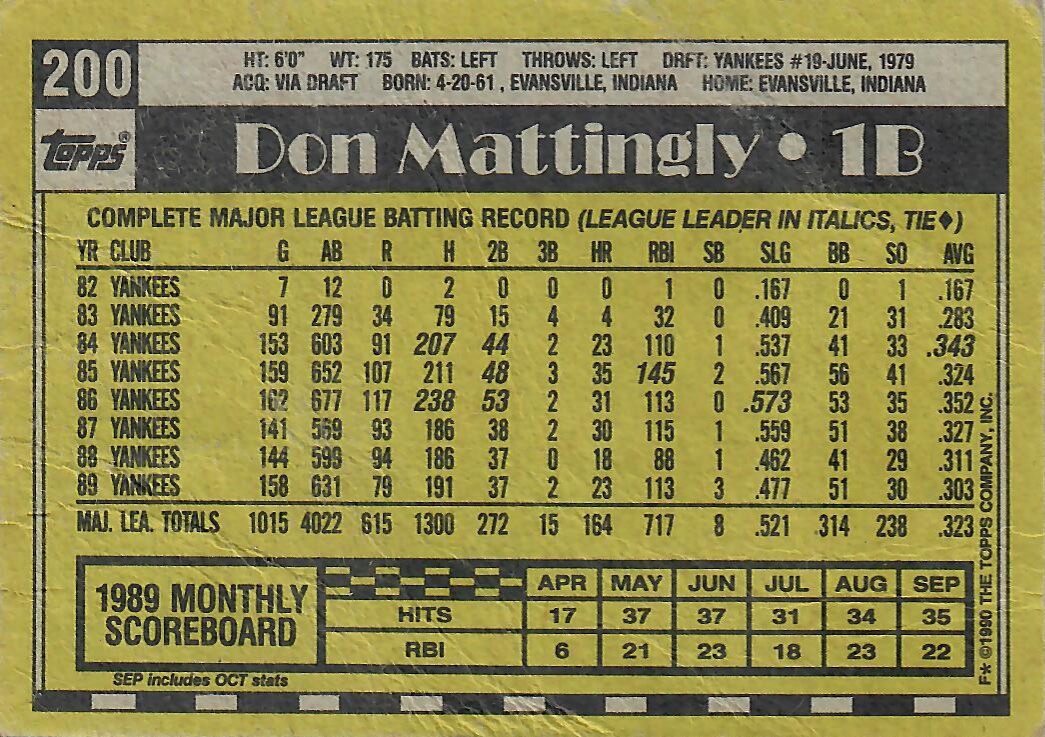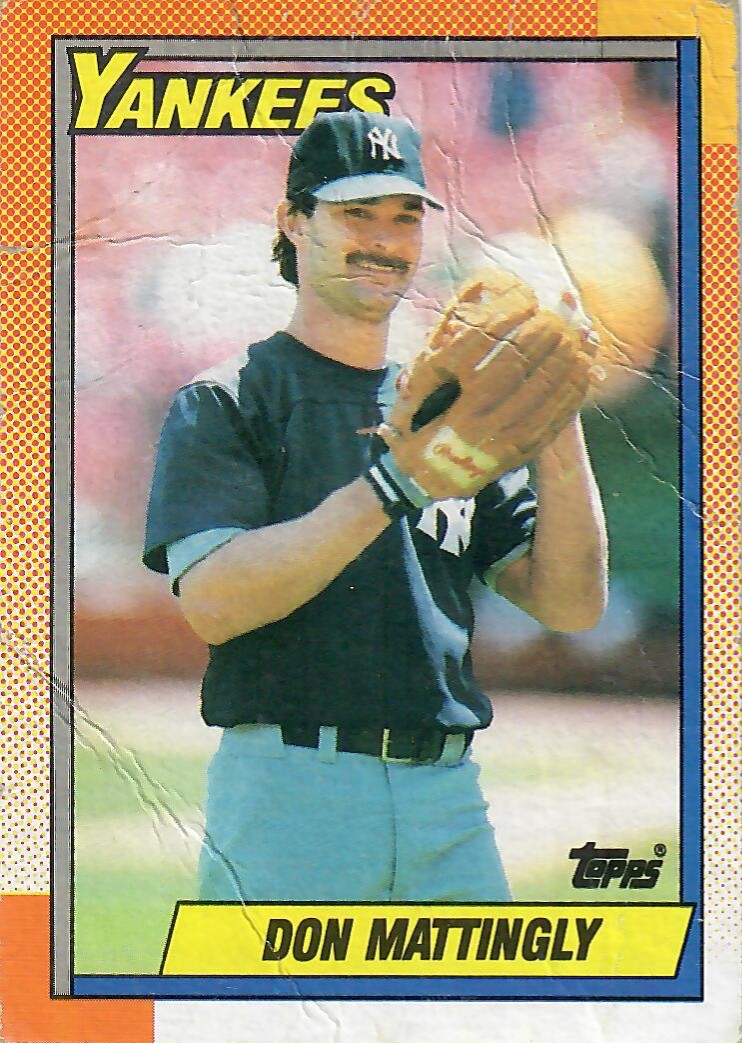- Player: Don Mattingly
- Set: 1990 Topps
- Card #: 200
- Type: Base
I first experienced the thrill of opening a pack of cards in my grandfather’s den on the South Shore of Long Island. At that time my fledgling love affair with sports and baseball cards coincided with the rise of the modern Yankee dynasty, forging a magical nostalgic fusion that remains strong all these years later. Right before I rip into a pack of cards, part of me still feels like a kid unearthing treasure from the top shelf of my grandfather’s closet. This new weekly column at Bronx Pinstripes will use a card from my collection to explore the hobby many of us grew up loving, as well as reminisce about a beloved Bomber.
One of the first cards I ever pulled was Don Mattingly (#200) from the 1990 Topps set (you can see that well-loved card above). My memories of Donnie Baseball are fuzzy because the first season I closely followed was 1996, the year after #23 retired. My clearest memory from Mattingly’s last season was Griffey scoring from first in Game 5 of the ALDS, breaking my 10-year-old heart. But I knew enough at that time to understand that Mattingly was important and undeniably cool: the name, the eye black, the crouched leg kick before he brought that sweet lefty swing around on an inside pitch–to me Donnie was the quintessential baseball player. Pulling him from that green wax wrapper while sitting on my grandfather’s brown shag carpet was a thrill.
A Very Brief History of Baseball Cards
Before we get too far down the basepath, let’s play a little catch-up for those who have been out of the hobby for a while. As baseball became a professional sport in the late 1860s, companies started using images of players to promote their product. This was most famously accomplished by tobacco companies in the early 1900’s. Topps came around in 1952, the second company to manufacture stand-alone card sets after Bowman in ‘48. Topps acquired Bowman in ‘56 which gave them a virtually unchallenged monopoly on the industry until ‘81 when their stranglehold was broken, bringing an influx of brands and innovative designs into the space throughout the 80’s.
A surge of new collectors followed and card companies pumped out millions of sets to meet the demand. This led to a glutted market, driving down the value of nearly everything produced between the late ‘80s and early ‘90s. Fathers that stockpiled sealed sets of 1989 Upper Deck or 1991 Fleer for their children’s college fund were left with bricks of nearly worthless cardboard, relics from what is now known as the “Junk Wax Era.” A steady decline followed, thanks in part to the ‘94 MLB strike, but in recent years the hobby has seen a resurgence thanks to exciting designs from Topps and Panini (the last two brands standing), unique autograph and memorabilia cards, and a bumper crop of new talented rookies to chase. Gary Vaynerchuk, entrepreneur and chairman of VaynerX, predicts a strong resurgence in the hobby over the next 2-3 years.
The Set
The 1990 Topps set was never regarded very highly by collectors. There were few prized rookies in its 792-card checklist, it was overproduced, and the design was a sharp deviation from Topps’ offerings throughout the late 70’s and 80’s, polarizing collectors. The more valuable and scarce set is 1990 Topps Tiffany which has the exact same design, but was limited to a print run of 15,000 and produced on white, glossy cardboard stock. For me, as is so often the case with things from our childhood, my nostalgia for this set remains strong. Just seeing the gradient border transports me back to being a kid. It’s still striking to me today because it is distinctly a product of its time, perhaps more so than any set since the iconic 1975 or 1987 Topps sets.
Despite its lack of scarcity, the set still maintains a bit of mystique thanks to two cards. Frank Thomas’ rookie card (#414) had a blank front name-plate error (later corrected), creating a rare collectible that still fetches thousands on the secondary market. The second was not a part of the set but was produced specifically for George H.W. Bush, featuring him in his Yale uniform and complete with stats from his junior and senior seasons with the Bulldogs (he batted .264 in 1948 with a dinger). In the intervening 29 years, several of the 100 copies given to the President have leaked out (one sold for over $25,000 in January 2019) as well as a less glossy version that allegedly escaped from Topps HQ.
Best from the Back: 238 Strikeouts
There is a lot to love about Mattingly’s stats on the back of this card. 145 RBIs in 1985: only Ruth, Gehrig, DiMaggio, and A-Rod ever had more in a season for the Yanks. 238 hits in ‘86: most ever by a Yankee. A .352 average in ‘86: top 20 all-time for a Bomber. Just look at his stats between ‘84 and ‘87. You could argue he was the best in the game during that stretch, without even factoring in the three Gold Gloves he won from ‘85-’87. But my favorite stat of his, and the one that best illustrates his mastery as a hitter, is how few times he struck out to that point in his career.
In 4022 at bats from 1982-1989, he went down on strikes just 238 times. 238. In 1,015 games. That’s nearly 17 at bats for every strikeout. Mark Reynolds, the current leader for strikeouts in a season, had 223 in 2009 alone, in 578 at bats for Arizona. Mattingly’s high through this point in his career was 41 Ks in a season. Six times he walked more than he struck out. The guy was truly the Hit Man and his numbers become more and more impressive as the game continues to evolve.
Mattingly in 1990
Unfortunately for Mattingly, 1990 was his worst in pinstripes. His infamous, problematic back, which he first injured while playing high school football and reinjured before a game in Milwaukee in June ‘87, reared its head again in ‘90 and limited him to 102 games. The ‘87 injury robbed him of his power and that campaign, which saw him hit 6 grand slams and slug a home run in 8 straight games, would be his last 30-homer season. In ‘90 his long ball total dipped to 5 and his .256 average was the lowest of his career. It was also the only season between ‘85 and ‘94 that he did not win the Gold Glove at first base and his first since his ‘83 rookie season that he was not named an All-Star.
Two problematic discs reduced the game’s most feared hitter to a shell of himself, but despite his sharp decline, he continued to endear himself to Yankee fans by humbly soldiering on for five more seasons, despite being in nearly constant pain. When he retired in January ‘97, George Steinbrenner summed up well the career of the legendary first baseman: “I don’t believe any player on the New York Yankees was ever as great as Don Mattingly in every way during my years as an owner. He was a great athlete and a great player. Some great athletes are not great human beings and vice versa. This man combined all of that.”
Value
Cards can be found in either graded or ungraded condition. Ungraded, also known as “raw,” means the card has not been encased or “slabbed” by a third-party card grading service. There are numerous grading services, but the largest and most recognized as the industry standard is Professional Sports Authenticator (PSA) which grades cards on a scale from 1 (poor) to 10 (gem mint). This card goes for about $1.00 in good raw condition (mine would be worth about $0.01 in its condition). The last graded card, a PSA 9, sold on eBay for $9.99. The last two Topps Tiffany Mattinglys, both PSA 9, sold on eBay for $17.50 and $56.
Notable Yankees in 1990 Topps
- #61 – Deion Sanders
- #200 – Don Mattingly
- #380 – Dave Winfield
- #701 – Bernie Williams (Rookie)
Bonus Hobby Knowledge: Base vs. Insert
A base card is part of the main set of cards. The above Mattingly is a base card from the 1990 Topps set. They are typically more common. An insert is an offshoot of the main set. They are inserted at different rates into the same packs that hold the base cards. As a result, they are typically rarer cards and are often numbered alphanumerically. They are further distinguished by designs that differ from the base set. A single set of cards can have multiple insert sets of different sizes and scarcities. They typically do not include statistics on the back as most base cards do and instead include highlights of player attributes or achievements. Since the late ‘90s, inserts have come to include player autographs and pieces of game-used jerseys, bats, bases and more.
You can follow Dan on Twitter @waxbombers.





